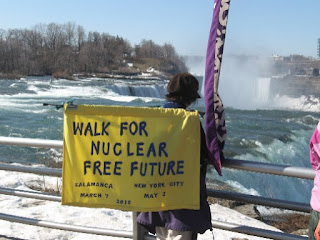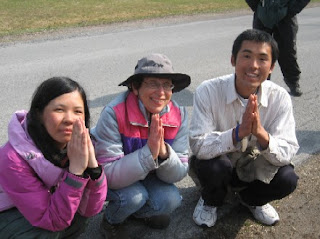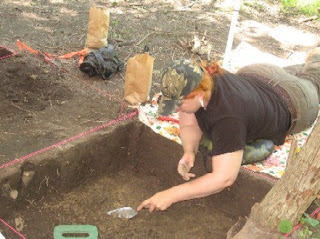Walk for a Nuclear Free Future: As a child, I believed that the world would be destroyed in a nuclear holocaust before I could grow up. As a result, the “what do you want to be when you grow up, dear” questions took on an abstract quality for me.
Well, I am happy to report that, all of these years later, I’m still alive and trying to figure out what I want to be when I grow up! I am much less happy to report that the world, which was not destroyed when I was a child, is still in peril. As long as nuclear weapons exist, the possibility that they could be used also exists. Despite my lifelong dread of a nuclear holocaust, I have never protested against nuclear weapons. Until I went to the federal prison camp in Danbury, Connecticut, in April of 2004, for crossing the Fort Benning fence while protesting against the School of the Americas (Western Hemisphere Institute for Security Cooperation), I had never met anyone who had been involved in protesting against nuclear weapons. There, I had the good fortune to meet Sister Ardeth Platte, who was serving a 41-month sentence for a Plowshares action at a nuclear weapons silo in Colorado. Ardeth quickly became a mentor and an inspiration for me. She explained to me that her action was an expression of love and of faith. That faith is also expressed by the World Council of Churches in its statement: “The production and deployment of nuclear weapons, as well as their use, constitute a crime against humanity.”
Since becoming friends with Sister Ardeth, I had wanted to do something to express my hope for a nuclear-free world as a way of honoring her determination and her sacrifice. So, when the opportunity presented itself for me to join a Walk for a Nuclear Free Future this year, I was happy to participate. I couldn’t do the entire 700-mile walk, but I was able to join this group for a little more than half of the walk. In March, I walked from Buffalo to Rochester, a distance of 100 miles, in one week. From April 11th until the first of May, I walked from Utica to New York City. This was a distance of approximately 265 miles. It took me through the Mohawk Valley and the Hudson River Valley into New Jersey and, finally, over the George Washington Bridge into Manhattan. Part of the mission of this journey was to visit all six nations of the Haudenosaunee (Iroquois Confederacy). I visited half of the nations: the Tuscaroras in Lewiston, the Senecas in their Tonawanda territory near Akron, and the Mohawks in their Kanatsiohareke community near Fonda.
Also, many of my fellow walkers were from Japan. I learned from them that people in Hiroshima and Nagasaki are still suffering the effects of the nuclear attacks. These people, called Hibakusha, survived the initial bomb blast but suffered from illnesses due to radiation exposure. Among them, there is a high rate of leukemia and other cancers, as well as thyroid problems. Their children have suffered, too, with birth defects and other health issues.
Similar health problems also plague people in places where nuclear weapons were developed and tested, both during World War II and later, during the “cold war,” which was called “cold” only because it didn’t involve direct conflict between the United States and the Soviet Union. The cold war claimed many victims throughout the world.
I heard terrible stories of birth defects in the Tuscarora territory, where leakage of waste materials from the Manhattan project was found. One of the walkers, Al White, a Cayuga who lives in the Seneca Nation’s Cattaraugus territory, talked of a baby who was born in the Tuscarora territory with two rectums. He said that people in the Cattaraugus territory are exposed to toxic materials that have leaked from the West Valley plant. “The biological and chemical warfare done to our people continues today and our people are suffering.”
When I arrived in New York City on May 1st, I went to the Riverside Church, where a conference was being held on the topic of a nuclear-free world prior to the start of talks on the Nuclear Nonproliferation Treaty at the United Nations. These talks are held once every five years. I heard a presentation called “Global Hibakusha.”
Claudia Peterson, a medical social worker, said that people in her community in Utah drank contaminated water and they ate contaminated meat and vegetables. The contamination, which affected parts of Nevada and Utah, was caused by nuclear weapons tests that had been conducted at the Nevada test site, located in the Nevada desert. Between 1951 and 1962, more than 100 nuclear bombs were detonated at this site.
“The U.S. government assured us that everything was safe. People were living downwind from the tests. We watched loved ones suffer and die.” Claudia’s father-in-law, a uranium miner, died of cancer at age 63. Claudia talked about the many family members who died of cancer. She said that she remembered holding her six-year-old daughter in her arms when the child died of cancer. She said that her sister died of melanoma at age 36.
“I wished that I could die,” Claudia said. “You are changed by loss and suffering. The heartache never goes away. The wound never heals. I never dreamed that I would have to do this. My story never changes.”
Abbacca Anjain Madison is a former senator of the Marshall Islands from Rongelap Atoll. She talked about the disastrous results of above-ground testing done by the United States in the Marshall Islands. She said that 67 atomic and hydrogen bombs were tested there. One of the most devastating tests was done over the Bikini Atoll on March 1, 1954. “At the crack of dawn, we saw a bright light in the west,” the former senator related. The light was accompanied by a loud noise. Small children cried. A strong wind blew. A bitter rain fell on everything. People washed in the rain, thinking that it was soap. Their skin became itchy, and they suffered pain in their eyes. The water was poisoned but the people didn’t know. No warnings had been given to them. Their bodies were covered in painful wounds. Their hair fell out. People suffered from lung, thyroid, stomach, and brain cancer.
A few days after the nuclear test, a research study, called Project 4.1 (Study of Response of Human Beings exposed to Significant Beta and Gamma Radiation due to Fall-out from High-Yield Weapons), was organized. It was done so without the consent or knowledge of the “human guinea pigs.” According to the final report of Project 4.1, people in the Ailinginae, Utirik, and Rongelap atolls experienced “significant” exposure to radiation, from 14 rads in the Utirik atoll to 175 rads in the Rongelap atoll. After the nuclear testing, “women gave birth to ‘jellyfish’ and to deformed and dead babies,” Abbacca siad.
“People are dying of radiation and cancer,” Abbacca explained. “The future is so bleak.”
She shared the story of the Marshall Islands as a cautionary tale. “Learn from our experience. Let us help each other.”
The United States ended its above-ground nuclear tests in 1962 and its above-ground nuclear tests 30 years later. The nuclear threat, however, still exists. An aging stock of nuclear weapons is maintained by several countries throughout the United States, Europe, and Asia. Depleted uranium, which is made from nuclear waste products, has been implicated in increased numbers of leukemia cases in Iraqi children.
Grand Island walk: It has now been two months since the Walk for a Nuclear Free Future ended. Since then, I have been walking around my own community. On Friday, July 2nd, I walked along the Niagara River. I picked wild raspberries and I watched boats in the river. After several hours, I reached Beaver Island State Park, where I met a group of archaeology students and their professor, Dr. Lisa Marie Anselmi. They were busily digging for artifacts of the early- to mid woodlands period. I got a tour of the site and an explanation of the project by a student named Jess. She showed me the “test pits” that were dug to determine if there was anything there of interest. If there was, then larger holes, called “units,” were dug. Jess showed me how the students sifted the dirt for artifacts. It was a lot like panning for gold! After I left the archaeology site, I walked to the beach, where I saw many people having fun in the sand and in the water.
It was a peaceful and educational walk. But I couldn’t forget that even this close to home, I was still affected by the dark legacy of the cold war. The fact that nuclear waste, as well as other waste products from the heavy industry on the Niagara Falls side of the river, has been identified in the Niagara River means that any fish caught there probably is not safe to eat. And, yes, people do go fishing in the river.
My experiences this spring and early summer have taught me that it’s long past time to get rid of the nuclear weapons.
Bertrand Russell once said: “War doesn’t determine who is right — only who is left.” Nuclear war changes that reality, too. In a nuclear war, it doesn’t really matter who is right because, when it’s over, no one will be left.







Thank you, Alice, for taking the extra steps to learn and to share Truth!